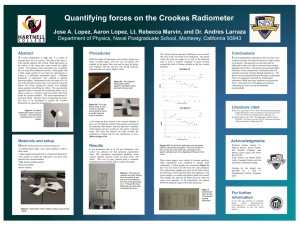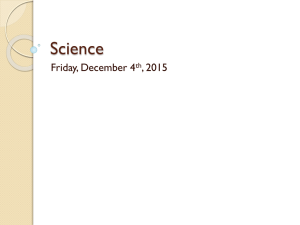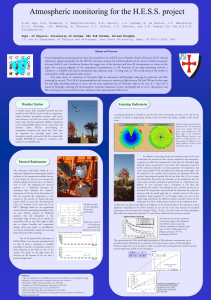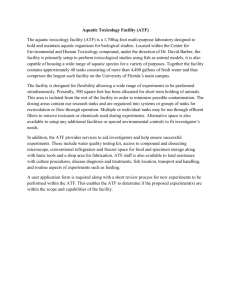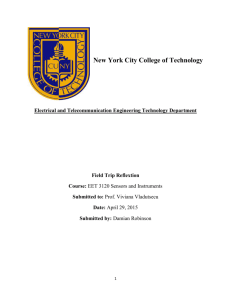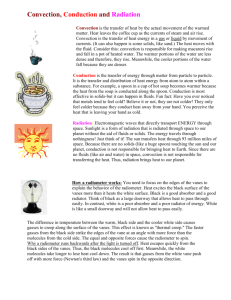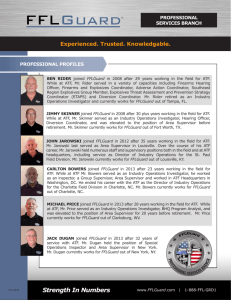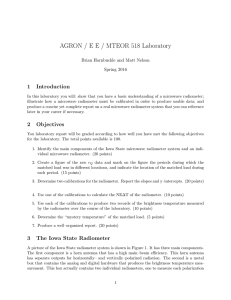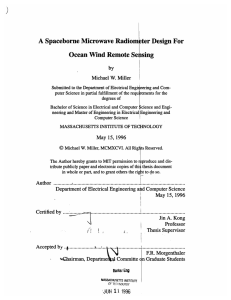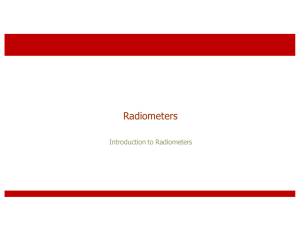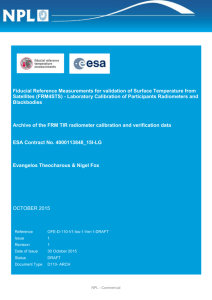2 Phase 2
advertisement
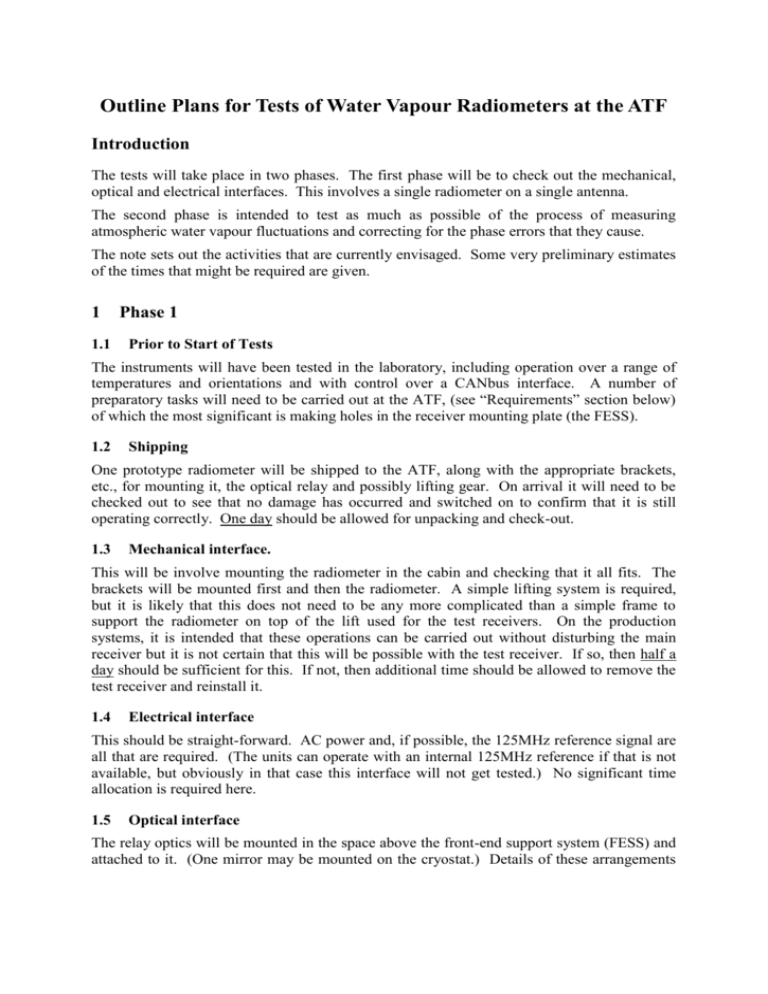
Outline Plans for Tests of Water Vapour Radiometers at the ATF Introduction The tests will take place in two phases. The first phase will be to check out the mechanical, optical and electrical interfaces. This involves a single radiometer on a single antenna. The second phase is intended to test as much as possible of the process of measuring atmospheric water vapour fluctuations and correcting for the phase errors that they cause. The note sets out the activities that are currently envisaged. Some very preliminary estimates of the times that might be required are given. 1 1.1 Phase 1 Prior to Start of Tests The instruments will have been tested in the laboratory, including operation over a range of temperatures and orientations and with control over a CANbus interface. A number of preparatory tasks will need to be carried out at the ATF, (see “Requirements” section below) of which the most significant is making holes in the receiver mounting plate (the FESS). 1.2 Shipping One prototype radiometer will be shipped to the ATF, along with the appropriate brackets, etc., for mounting it, the optical relay and possibly lifting gear. On arrival it will need to be checked out to see that no damage has occurred and switched on to confirm that it is still operating correctly. One day should be allowed for unpacking and check-out. 1.3 Mechanical interface. This will be involve mounting the radiometer in the cabin and checking that it all fits. The brackets will be mounted first and then the radiometer. A simple lifting system is required, but it is likely that this does not need to be any more complicated than a simple frame to support the radiometer on top of the lift used for the test receivers. On the production systems, it is intended that these operations can be carried out without disturbing the main receiver but it is not certain that this will be possible with the test receiver. If so, then half a day should be sufficient for this. If not, then additional time should be allowed to remove the test receiver and reinstall it. 1.4 Electrical interface This should be straight-forward. AC power and, if possible, the 125MHz reference signal are all that are required. (The units can operate with an internal 125MHz reference if that is not available, but obviously in that case this interface will not get tested.) No significant time allocation is required here. 1.5 Optical interface The relay optics will be mounted in the space above the front-end support system (FESS) and attached to it. (One mirror may be mounted on the cryostat.) Details of these arrangements have yet to be determined and this is becoming urgent. Access to this volume is therefore required. Provided all the mounting holes in the FESS are already in place and no mistakes have been made, half a day should be sufficient for the installation. In addition to the physical mounting arrangements, the alignment strategy needs to be worked out. For the production systems we expect to carry out the alignment before installation using laboratory measurements and a set of specially made jigs. This is not likely to be practical for the prototype systems, so it will probably be necessary to do an in situ alignment. The easiest way to do this is to point the antenna at the Sun, or possibly the Moon, and then maximize the signal seen by the radiometer. This requires an arrangement for adjusting the mirrors with the telescope tipped. The present plan is to do this with long flexible extensions to the adjustment screws, which can be operated from the floor of the receiver cabin. This requires access to the cabin with the telescope tracking the Sun or Moon. If this is not possible, then we would have to consider remote motorized adjustment of the mirrors, which is a considerable complication. A further half day should be allowed for alignment. 1.6 Functional Tests The radiometer will need to be checked out to see that its temperature control and other systems function correctly in this environment. This will be come evident during the subsequent measurements so no time needs to be assigned for this. It may be worthwhile to check that the instrument’s calibration is still correct. This involves inserting an ambient and, if possible, a liquid-nitrogen-cooled load into the beam. If it is not practical to do this in the cabin then the calibration should be checked before installation. A few hours should be allowed for this. The most complex measurement to be made is the efficiency with which the optics couple the radiometer to the sky. This requires: a) performing sky-dips, i.e. stepping the antenna over a range of elevations from near zenith to say 15 degrees and taking measurements at each point. This needs to be done with a clear sky and under as stable conditions as possible – i.e. almost certainly at night. If possible measurements with different amounts of water in the atmosphere will be made. Time should therefore be assigned on at least two nights although this can be planned as part of other activities, as the sky dips should only require a few tens of minutes of actual telescope time. b) making scans across the sky in the vicinity of the Sun to determine the level of spill-over past the secondary mirror. The scans would need to cover about 10 degrees of sky at a rate of perhaps 0.1 degrees per second. Exactly how this can best be done depends on the capabilities of the telescope control software. Once the procedures have been worked out this test should only require about one hour of telescope time on a clear day. This and other data acquired when the telescope is doing other things may also turn out to be useful in the context of the atmospheric modelling work, so some reasonably large data sets will be acquired if the data acquisition system can handle them. 1.7 Electromagnetic Interference In principle we should check for any interference problems between the radiometers and the receivers. In particular a check for leakage of the radiometer Gunn frequency (91.655 GHz) should be made – this is expected to be small – and the level of the third harmonic (274.965 GHz) should be measured. This signal will almost certainly be seen by the astronomical receiver (when it is tuned to this frequency) by reflection of the secondary mirror. A good quality spectrum analyser should be sufficient to measure the level, or alternatively some test using the astronomical back-end could be derived. Interference in the other direction is not expected as there is no receiver in the 183GHz range on the ATF, but checks for any spurious signals should be made. A few hours should be allowed for these tests. 1.8 Control System At some point during this phase (or at least before the start of the next phase) the interface between the WVR and the ALMA control and monitor system needs to be checked out. This is however essentially all software, so the radiometer does not need to be on the telescope or even at the ATF in order to do this. A set of software already exists that can exercise all aspects of the operation of the radiometers and take data from them over the CANbus. 1.9 Conclusion of phase 1 A report noting any difficulties that have been found and in particular confirming the optical coupling values will be produced. Unless any major problems have been found, or it is needed elsewhere for the tests of the control interface, the radiometer can remain at the ATF. It could in fact probably remain installed on the telescope. 2 2.1 Phase 2 Shipping The second radiometer, which will by then have been modified to be as similar as is practical to the first, will be shipped to the ATF. As before, one day should be allowed for unpacking and checkout. 2.2 Installation and Check-out This radiometer and its associated optics will need to be mounted in the second antenna and the alignment adjusted. If the first radiometer has been removed from its antenna it will also need to be re-installed. The optical coupling and calibration of both radiometers will need to be checked. A valuable measurement will be to make simultaneous sky-dips with the two antennas to see how accurately the two sets of sky brightness measurements agree. These operations should go rather more quickly than the original installation, so between two and three days are likely to be needed for all this. 2.3 Software Integration For these tests it will be highly preferable to run the radiometers with something resembling the real ALMA control and monitor system, so that the data from them can be stored in the archive alongside the information being obtained from the ATF’s backend and other systems. (If this turns out not to be possible, it would of course be possible to have a separate simple data acquisition task running which would store the radiometer values, along with accurate time stamps, and then compare these results with the data from the backend off-line, but this is clearly undesirable.) Note that it is not intended to perform any real-time phase correction: the data will be stored and the analysis will be carried out later. Discussion is needed on what tools will be available to extract the appropriate quantities from the ALMA archive. It is too early to give an estimate of how much time will be needed at the ATF to check-out these aspects. If everything has been well prepared it should be only a few hours. 2.4 Observations The interferometer should track a bright unresolved source for periods of order tens of minutes at a time, recording the fringe phase (and amplitude as a diagnostic), while the radiometers are measuring the sky brightness temperatures. This requires that the basic interferometer operation has been fully debugged at this time – i.e. system operates reliably, the instrumental phase is stable and the baseline, passband, etc. have been calibrated reasonably well. The integration times should be short (~1 second) and the source should be bright enough to make phase measurements possible at level of a few microns of path, i.e. a signal to noise ratio of ~100 at 230GHz or ~250 at 90GHz. This will need to be done under a range of different conditions – day / night, dry / less dry, windy / still – so that as many as possible of the various sources of phase error and drift can be identified and the overall performance evaluated. A second type of measurement involves switching between two or more sources at different positions in the sky. This will show how well the phase can be tracked when switching to reference sources and it should enable us to make a reasonably good evaluation of how accurately the radiometers will be able to correct for the larger phase changes that will occur on longer baselines than will be available at the ATF. It is anticipated that these observations will be spread over a considerable period of time – certainly several weeks. To start off with a good deal of attention will have to be paid to working out the best procedures and finding out what tests give the most useful information. Later on it should be possible to take this data in a rather routine fashion in between other kinds of tests. The total amount of telescope time required is hard to estimate, but is likely to be or order a few tens of hours. 2.5 Conclusion of Phase 2 A considerable amount data analysis will need to carried out. This will of course be started in parallel with the observing and feedback will be provided to guide the measurements. It will however continue for some time afterwards in order to extract as much information and put it into a report. The question of whether the prototype radiometers remain on the telescopes at the end of these tests, or are returned to the laboratory or taken to another site should remain open for the present. 3 Requirements In order to carry out these tests, a certain amount of preparation is required at the ATF. 3.1 For Phase 1 a) The FESS will need to have holes cut in it for the beam to pass through and for the attachment of the radiometer and the optics. b) A lifting scheme needs to be devised and any hardware required made. There are two steps: a) the lift from the ground to level of the cabin door, and b) the lift from the floor of the cabin up to the radiometers position near the roof of the cabin. The first will presumably be done with a hoist so lifting “eyes” will be installed on the radiometers. For the second, it is hoped that it will be possible to make use of the lift that was used for the test receiver. The essential information that is needed here is how high that lift can go. A frame can then be designed to sit on top of the lift which will get the radiometer up to the height needed. c) Access to the widget space above the receiver will be required for alignment purposes. d) Procedures need to be drawn up for the safe operation of the telescope drives with a person in the cabin carrying out the alignment. (A preliminary discussion of this with the site safety officer has already taken place.) e) The antenna control software needs to be able to perform sky-dips, to point at the Sun and to make scans across the position of the Sun. f) The astronomical test receiver plus a spectrum analyzer or backend are needed for the EMI measurement. g) For testing the WVR control and monitor interface, an initial version of the routines that communicate with the WVR will need to be provided (but note that this does not necessarily have to occur at the same time as the other tests). 3.2 For Phase 2 The main prerequisite is of course that the ATF is operational and that it is capable of making observations the observations outlined in 2.4, i.e. that it has sufficient signal to noise ratio and stability and can operate continuously with short enough integration times. Specifically we need to be able to measure phase to about 2.5 degrees at 230 GHz or 1 degree at 90 GHz in timescales of ~1 second. In addition: a) Items a) to d) noted for Phase 1 need to be repeated for the second antenna. b) A version of the control and monitor software, capable of taking data from the radiometer and storing it with the interferometric data as well as timing information, is highly desirable. c) If the data is put into some form of archive then software to recover it in an accessible form is essential. REH 11th Dec 2003 updated 20th May 2004
